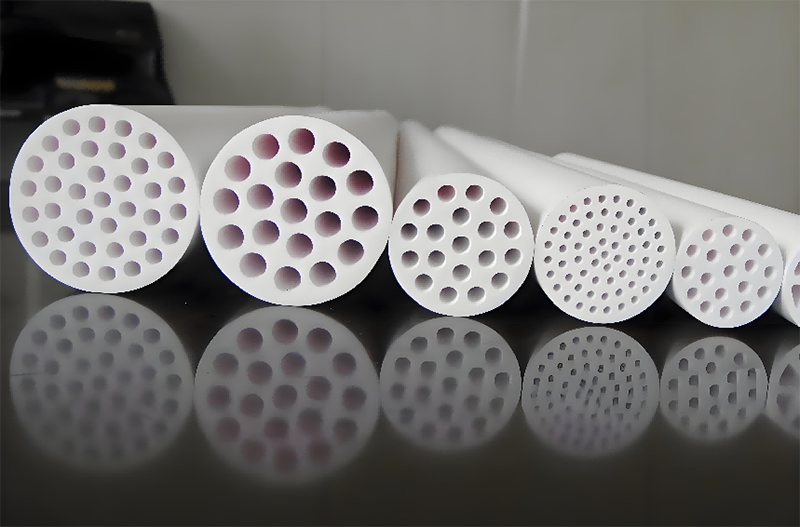News

1.Juice concentration and clarification
In the production of fruit juice, both microfiltration and ultrafiltration have reached a large-scale application level in the clarification of pressed or pre-filtered fruit juice. The traditional fruit juice processing technology includes the crushing of berries, pressing, the filtration of the crude filtrate and the fine processing. These processes require the addition of processing agents, such as pressing aids and filtration aids.
The application of inorganic membrane technology is of great significance for improving the quality of fruit juice and reducing operation costs. Ultrafiltration can combine filtration and pressing in one unit operation, reducing production costs. Inorganic membrane treatment helps maintain the original flavor of fruit juice. Moreover, inorganic membranes have advantages in fruit juice filtration, such as high permeation flux, low protein adsorption, good mechanical strength, resistance to high-pressure backwashing, no deformation during the process, and good thermal stability allowing for high-temperature in-situ disinfection.
Apple juice clarification
The clarification of apple juice using ceramic membranes is one of the widely applied and successful examples in industry. The longer service life of ceramic membranes and the unchanged flavor and aroma of the filtered products make this technology superior to other separation techniques such as diatomite filtration and polymer membrane filtration.
Clarification of other juices
1)Cranberry juice:Ceramic membranes have been used commercially to clarify cranberry juice.
2)Tomato juice : Integrated membrane technology has been widely used in the production and concentration of tomato juice. During microfiltration concentration, the permeate flux does not change much, and the concentration factor can reach 2.5. Further use of reverse osmosis membrane can concentrate the juice to 14-15 Brix (Brix sugar content), and the permeate flux is 20 l•m-2•h-1.
2.Clarification and separation technology in beer brewing
Inorganic ceramic membranes are used in beer production mainly for bacterial removal to clarify beer and to recover beer from tank bottom sediments.
The presence of bacteria or microorganisms can affect the flavor of beer and shorten its shelf life. Traditional filtration methods, such as using diatomaceous earth, can remove yeast and some bacteria, but they are not very effective in retaining and eliminating bacteria. Therefore, pasteurization is often required before canning to kill bacteria or microorganisms. However, due to the high-temperature heat treatment involved, it often leads to the oxidation of some aromatic compounds, affecting the flavor of the beer. At the same time, the bacterial cells are not completely removed after pasteurization.
The cross-flow microfiltration technology of ceramic membranes can be used to replace pasteurization and directly clarify and filter beer. By adopting this technology, the thermal treatment of beer can be avoided, achieving the purpose of sterilization and clarification while ensuring the flavor and taste of the beer.
Technical features:
1)Beer can be recovered from spent yeast.
2)All kinds of microorganisms, yeast, pectin, suspended particles and other substances that affect the quality of the beer can be completely removed.
3)The easily damaged aromatic substances in the product will not be damaged, allowing for direct canning of the beer.
4)The resulting beer is clear in color, has a long shelf life and high quality.
5)The brewing process becomes hygienic, simple and economical.
6)High separation efficiency and stable filtration effect.
7)Ceramic membranes are resistant to acids, alkalis, organic solvents and oxidants, have good regeneration performance and a long membrane service life.
3.Wine clarification and filtration
The wine-making process is extremely complex, and several clarification processes are required to stabilize the wine quality. Traditional separation methods include decanting, fining, cold treatment and filtration. Through the decanting process, suspended colloidal particles in the wine that can cause turbidity, such as grapes, yeast, proteins, polypeptides, pectin, gums, unstable grape pigments, tannins and others, can be removed, thereby enhancing the taste and clarity.
Refined clarification is used in multiple stages of the wine production process, including the removal of phenols from pressed juice, the reduction of proteins in wine after fermentation, and the reduction of the bitterness of new wine before bottling. In the past, a relatively good separation method was to use a small amount of refined clarification cleaning agent to adsorb particles or neutralize charged particles to make them flocculate and settle, obtaining clear wine juice. Cold treatment can cause the deposition of potassium bitartrate and calcium bitartrate crystals. Traditional filtration steps include initial filtration with diatomaceous earth, fine filtration, and organic membrane separation of bacteria.
With the development of ceramic membrane technology, ceramic membrane cross-flow microfiltration and ultrafiltration techniques can be adopted to replace clarification, sterilization and stabilization treatment of raw wine, making the wine-making process simple and economical while maintaining the mellow flavor of the wine.
Technical features:
1)Can completely remove all kinds of microorganisms, yeast, pectin, suspended particles and other microorganisms that affect the quality of wine.
2)The easily damaged aromatic substances in the product will not be damaged at all, allowing for direct canning of wine.
3)Can produce wine products with bright color, long shelf life and high quality.
4)Make the wine-making process hygienic, simple and economical.
5)High separation efficiency and stable filtration effect.
6)Ceramic membranes are resistant to acids, alkalis, organic solvents and oxidants, have good regeneration performance and long membrane service life.
